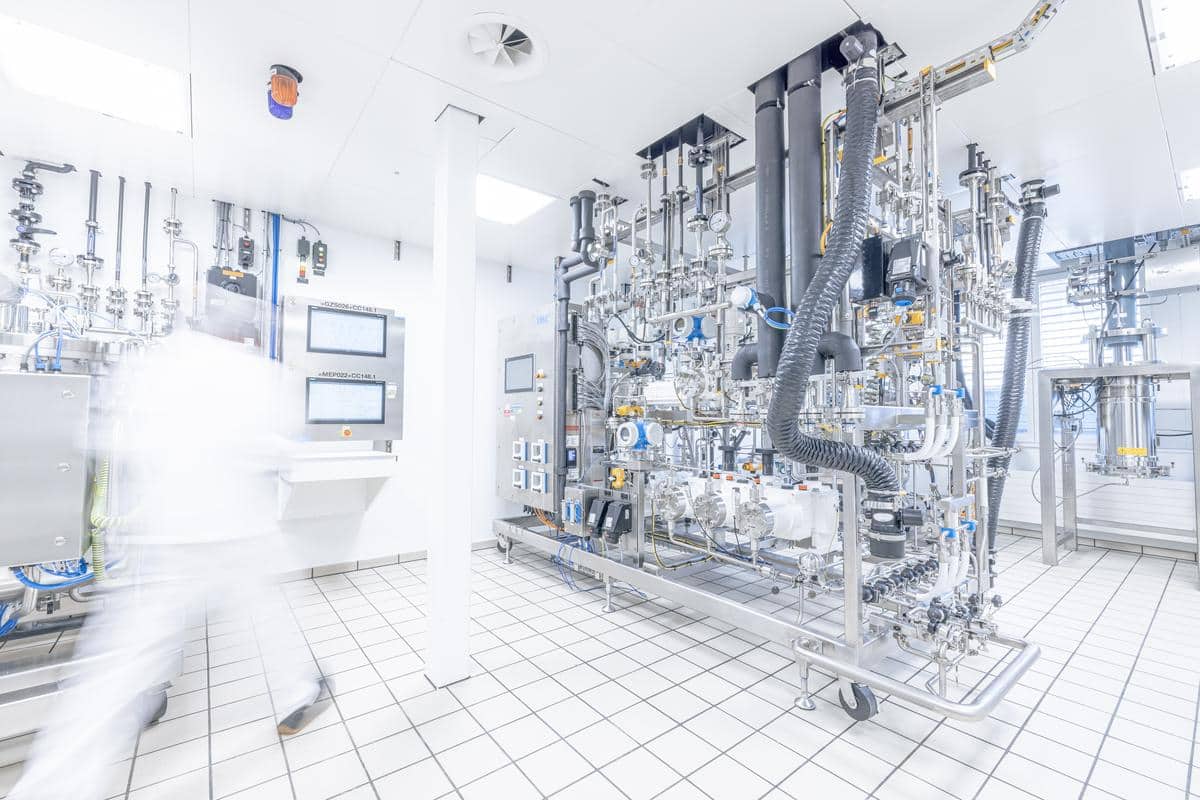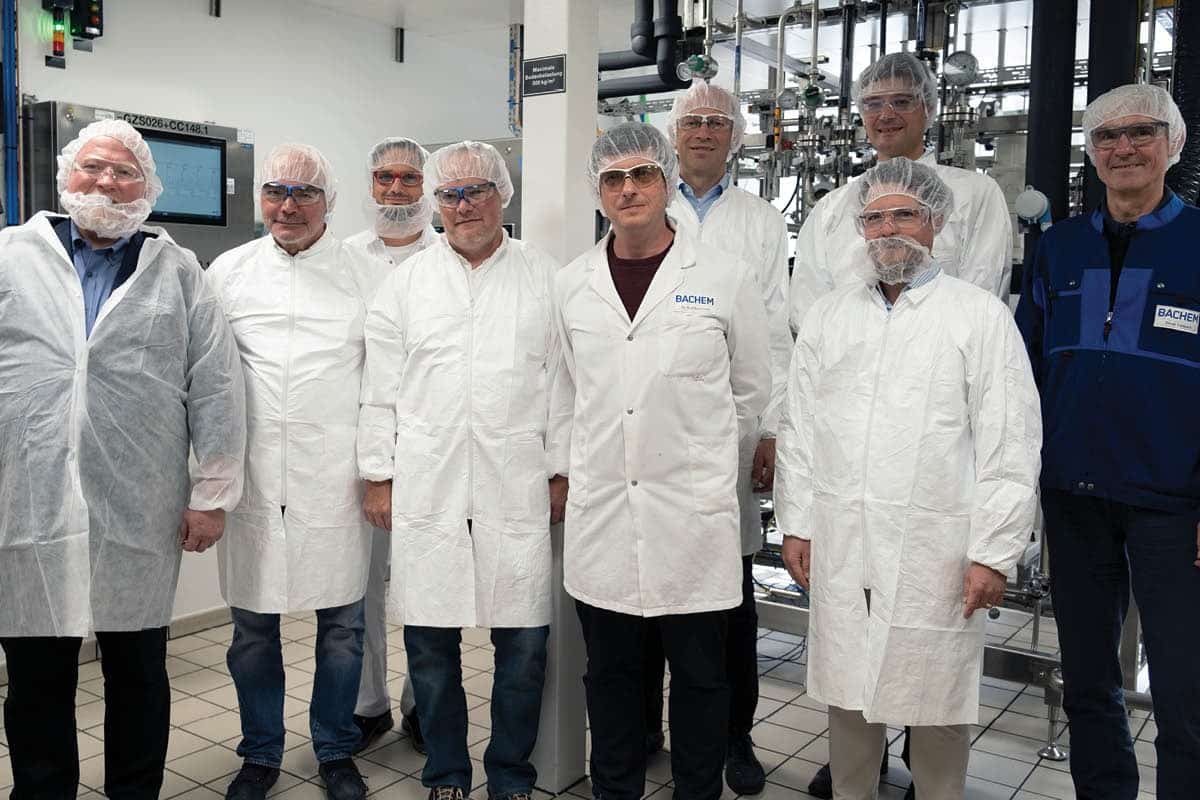While they were visiting Bachem, we had the chance to sit down and talk with Prof. Massimo Morbidelli, Dr. Lars Aumann, and Dr. Thomas Müller-Späth who together, have brought Continuous Chromatography from an academic idea to a potential new industry standard that Bachem is piloting for use in TIDES.
Get an insight into a conversation about lessons in innovation, what it is like to partner with Bachem, and – of course – the potentials of continuous chromatography.
Professor Morbidelli and Lars Aumann – you published a seminal paper on continuous chromatography in 2007. How fast did you think this technology could be applied for GMP-manufacturing, the standard used in manufacturing ingredients for medicines?
Dr. Lars Aumann: We did not have experience in how long these things take. We knew that the pharma is tightly regulated, of course. I expected something like six or seven years. But it took us a bit longer.
Prof. Massimo Morbidelli: Yes, the paper is now about 16 years back.
How did it all start?
Dr. Lars Aumann: I remember one evening Professor Morbidelli called me and said, “Lars, we need to develop a continuous chromatography system. We started thinking and came to the idea of how to establish a linear solvent gradient in a multicolumn system. That really was the core idea.
Prof. Massimo Morbidelli: The project started in our research group at ETH Zurich in 2004, where we built the first prototype. The related patent was granted in 2005, and the spin-off company was founded about a year later.
Continuous Chromatography – A Game-Changer
Continuous chromatography is set up for large-scale purification and provides significant advantages of quality, capacity, cost and sustainability.
- Innovative, fully automated system using two chromatography columns.
- Greener downstream process for GMP large-scale peptide and oligonucleotide manufacturing.
- Compared to single-column batch purification, solvent consumption typically decreased by over 30%.
- Reaches the target product purity often with a higher yield, typically 10% more.
The method is also called Multicolumn Countercurrent Solvent Gradient Purification (MCSGP).
What were the biggest challenges to bringing the technology to life?
Dr. Lars Aumann: One of the first challenges was to find funding for the equipment. That required making sure the process would work. One of the PhD students wrote a computer program so that we could verify the theoretical findings. With that, Professor Morbidelli could get a budget to build the first prototype.
And what did that prototype look like?
Dr. Lars Aumann: The prototype had eight columns – instead of the two used today. And then, we began to simplify it.
Prof. Massimo Morbidelli: We loved our eight-column prototype, but everyone else thought it was ugly. [laughs]
Dr. Lars Aumann: Because we started in a research group, we had highly complex equipment to run all sorts of processes. But if for larger scales, simpler is better. So we reduced to six and then later a four-column system, then around 2007 a three-column system and finally got down to two and added a bit of our own equipment, what you can see as a the (Contichrom) CUBE today.
Did you see commercial potential from the start?
Prof. Massimo Morbidelli: At the beginning, we were convinced about the idea’s scientific and technical innovative value, and we received a lot of support within the research group. The commercial considerations came at the moment of founding the spin-off company, largely due to the initiative of the former members of the group: Lars Aumann, Thomas Müller-Späth, and Guido Stroehlein.

The companies did not see the potential, but the researchers did?
Prof. Massimo Morbidelli: Yes. There is an interesting lesson here. Even big companies that had a full grasp of everything happening in their market were very skeptical because of the complexity of the technology – at least of the first prototype. The fundamental detailed understanding of our doctorate students motivated us to further develop the technology to the level it has reached today.
What was the biggest challenge to get this equipment to work in a GMP-environment?
Dr. Lars Aumann: The largest challenge to getting the technology ready for GMP-manufacturing was to build equipment that could deliver the scalability volumes. It is a bit of a chicken-and-egg problem. You show it to companies at a small scale, and they ask to see it operate at a large scale. But operating at a large scale requires costly equipment, which again requires a company to finance it. So we needed partners to take the first step, take the risk, and say, okay, we believe in this technology. We finally found one in a pharma company we worked with to build a first prototype that could be manufactured under GMP – but initially not for TIDES. We first applied continuous chromatography to molecules like monoclonal antibodies.
When did you start working with Bachem?
Dr. Thomas Müller-Späth: Bachem was the pioneer to use continuous chromatography for peptides. We had had an on-and-off dialogue with Bachem going back many years. Then, around 2016, things kicked off, thanks in large part to the initiative of Ralf Eisenhuth after he visited our workshop at ETH.
You said Bachem was the first partner you worked with in TIDES. How is using continuous chromatography in TIDES different from other molecules?
Dr. Thomas Müller-Späth: In TIDES, the active ingredient and the impurities you want separate are very similar, much more than, say, in antibodies. The removal of these product-related impurities requires a special continuous chromatography process.
Dr. Lars Aumann: Yes, manufacturing TIDES is much more complicated than other molecules. Every imaginable factor, from temperature to PH-level concentration, impacts the product’s purity. It takes a lot of expertise to handle and understand chromatography for peptides.
HOW DOES CONTINUOUS CHROMATOGRAPHY WORK?
MCSGP is a fully automated system using two columns that are operated in counter current mode. It internally re-purifies side-fractions called side-cuts, while continuously eluting product fractions by changing from one column to the other. During gradient purification, weak and strong absorbing impurities are separated from the product.
And how has your experience been working with Bachem?
Dr. Thomas Müller-Späth: My impression is that Bachem is a company that is very open to new technology, on the lookout for innovations, and always aiming to improve. Also, it was always easy to work across different levels of hierarchy and engage with technical teams and senior leadership.
Prof. Massimo Morbidelli: I really think that openness to technology is critical to industrial success. Biopharmaceutical companies, which tend to be conservative for good reasons, are in what is called a “race to be second.” They don’t want to be the third if a technology is successful, but they are also hesitant to take the risks of trying out new technology first. So, when a company like Bachem is willing to go first, this shows a very high level of understanding of new technology and a very open-minded culture.
Looking toward the future – what’s next for continuous chromatography as a technology?
Dr. Thomas Müller-Späth: We are looking at a new industry standard. The technology allows very sustainable manufacturing of large volumes of oligonucleotides and peptides. And we know large-volume solutions are desperately needed due to the use of peptides in new drug indications such as obesity. In addition, we believe the technology has applications across a broad range of other molecules beyond TIDES.
Have you noticed an increased interest in continuous chromatography in the TIDES industry?
Dr. Thomas Müller-Späth: Absolutely. Working with Bachem as the market leader has certainly helped raise interest, paving the way for this technology and applying scale and infrastructure to its use.
So, what is your elevator pitch for continuous chromatography?
Dr. Thomas Müller-Späth: It saves a lot of time. The technology can deliver your targeted volumes much faster. You can run more projects, reduce waste, and produce larger quantities of drug material.
Prof. Massimo Morbidelli: If you take the bird’s eye view, in history, we have seen every industrial sector, from cars to textiles, go from producing batches to continuous operation. We have never seen the opposite: from continuous to batch. And now there is equipment that allows you to purify biopharma ingredients continuously. So it’s a big deal.
In your work with companies like Bachem, you’ve seen both the commercial and the academic world. What’s your advice to young academics who want to commercialize an idea?
Dr. Lars Aumann: Never give up. [everyone laughs]
Dr. Thomas Müller-Späth: Just try it. You will gain a lot of experience.
Prof. Massimo Morbidelli: You need to be willing to take a risk. These guys [pointing to Thomas and Lars] could have gotten a job at a big corporation with a comfortable life. Instead, they chose to create a start-up. It can be challenging, and it is not guaranteed to pay off. Students today have much more entrepreneurial passion than two or three decades ago.
Partnerships are key to long-term success
Our commitment to collaboration extends from smaller academic and industrial research projects to major global pharmaceutical companies. Bachem’s flexibility is demonstrated by its ability to adapt to different needs, offering the full range of TIDES API manufacturing on a global scale. Bachem is not only a partner for cutting-edge research, but also a reliable Contract Manufacturing Organization (CMO) for those seeking manufacturing solutions for approved drugs.
Bachem’s holistic approach, encompassing collaboration, quality, reliability, sustainability and innovation, positions it as a pioneer in oligonucleotide manufacturing, driving global impact and contributing to the advancement of science and medicine.
Subscribe to our general newsletter
"*" indicates required fields
